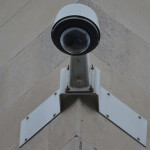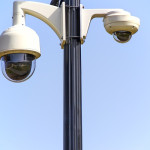PTZ Cameras: The Basics
When it comes to security cameras, there are various types that work better in certain situations than others. Thanks to their specialized functions, PTZ cameras are ideal for monitoring large, high-traffic areas.
PTZ stands for Pan, Tilt, and Zoom, which means these security cameras can provide improved surveillance. These functions can be controlled manually (via monitoring software or a joystick) or automatically (via camera management software). Actively keeping an eye on the feed and the ability to manipulate the field of view means security staff can respond to any incidents that may arise quickly.
When employing camera management software, you have the option of setting up guard tours, which enables the camera to automatically move to set locations on a schedule. In addition, some PTZ security cameras offer auto-tracking, which can automatically follow a moving target (such as a person or car).
How Does PTZ Work?
Pan
- The camera can swivel left and right for a wide area of coverage.
- Pan can range up to a complete 360 degrees or less.
Tilt
- The camera can tilt up and down for a wide vertical range of coverage.
- Tilt will vary by camera model, with a maximum of 180 degrees.
Zoom
- Optical zoom physically adjusts the camera lens (by changing the focal length) to zoom in and out (allowing the camera to maintain image quality).
- The amount of optical zoom is expressed as #x (ex. 18x), which represents how much the camera can zoom (change the lens focal length).
- Digital zoom blows up the image using software. This often results in pixilated images when zoomed too far, and thus, is not recommended.
As previously mentioned, PTZ cameras are ideal for surveillance of large areas including parking lots, common areas in schools or businesses, and convention centers. You may monitor the overall area while zeroing in on any suspicious activity. When paired with fixed network cameras that handle important locations such as entrances and exits, you can create a very flexible and functional surveillance system. With the fixed cameras maintaining an eye on vital points, the PTZ cameras are free to move around as needed. Furthermore, PTZ cameras are available for indoor or outdoor use in a variety of styles (but most commonly dome style).
Do you employ PTZ cameras on your own property? Share your own tips for utilizing these cameras with us on Facebook, Google+, Twitter, LinkedIn, and Pinterest.
Browse our selection of PTZ security cameras and more to suit your surveillance needs. Visit SecurityCamExpert.com or call 888-203-6294 today!
The Benefits Of PTZ Cameras
Looking back, Pan Tilt Zoom (PTZ) cameras have come a long way. As technology as has advanced, PTZ cameras have decreased in size and weight while offering even better features and functions.
These high-quality PTZ cameras are ideal for monitoring large, open spaces both indoors and outdoors. Some examples include casino, malls, airports, and stadiums, where effective and efficient surveillance is necessary.
As with any security system, selecting the right PTZ camera system comes down to individual security needs. Here are some important features to consider when choosing PTZ cameras.
Video Analytics
Now nearly all PTZ systems are equipped with video analytics which provide numerous benefits:
- Directional Behaviors – notify operators or active cameras when someone or something moves against the designated flow of traffic (ex. someone trying to walk into an exit path).
- Abandoned Object Behaviors – enables video system to alert security personnel when an object (ex. backpack, box, or briefcase) is set down and left unattended.
- License Plate Recognition, Facial Detection, Perimeter Detection & related analytics.
- Tripwire Behavior – activates a camera or triggers an alarm or other operations when a person or object moves into a restricted area.
Auto-Tracking
Arguably one of the most valuable features of PTZ cameras, auto-tracking controls the PTZ actions of a camera to automatically track (keep in field of view) an object in motion. This can be triggered manually or automatically by defined rules. Once a rule is triggered, the camera automatically zooms in and tracks the defined target.
Advanced Video Compression
The H.265 compression standard enables much higher compression ratios with lower bandwidth and storage requirements than before, providing higher resolution images and deeper systems integration. However, optimized implementations of the H.265 codec are emerging, like the Smart H.265+. In comparison to the standard h.265 video compression, Smart H.265+ reduces bit rate and storage requirements by up to 30 percent.
High-Definition Video Over Coax
Legacy coax systems can be easily upgraded to HD video using existing analog infrastructure thanks to HD video over coax. With this option, there is no latency in system responsiveness and no video compression, so the images maintain a high level of detail without stretching or distortion. In addition, there is no need to install a separate cable to control PTZ since coaxial cable allows for bidirectional data transfer. Overall, this is a cost-effective way to upgrade PTZ cameras.
Infrared (IR) Illumination
With PTZ cameras, IR illumination is applied as needed. There is usually an array of three distinct areas of infrared illuminators – each with a different angle of dispersion for the IR light: wide angle, telephoto, and interim angle.
As an example, when an operator optically zooms in from wide angle to telephoto, IR illuminator LEDs will turn on and off to provide the appropriate illumination. And when the camera is in zoom mode, it adjusts the IR illumination so that the system is not flooding the entire 120-degree view. These automatic modifications illuminate the area in view, producing better video and reducing the amount of power required.
Video Quality Expectations
Zoom Factor vs. Focal Length – Keep in mind that a higher zoom factor does not always provide a better video image. The focal length of the lens will provide a better indication of what is appropriate for an application.
Plastic vs. Glass – Remember not all lower domes (the protective housing at the bottom of a PTZ camera) are the same. While most manufacturers use a plastic lower globe to protect the camera and optics, this can offer a lower degree of optical clarity. As the camera pans up toward the horizon, it begins to view through the globe in areas where it has the least uniformity (where most optical distortions can occur).
Glass lower globes (or a flat piece of glass, as provided by some companies) are more optically pure and consistent in comparison. These glass coverings enable dome systems to feature higher resolution sensors and longer optical zooms thanks to their clear and consistent nature.
Some modified lower dome designs allow for above-the-horizon viewing – ideal for those who need to monitor rough terrain or scenes on different planes of view.
Thinking about installing a PTZ system on your property? We carry a great collection of quality PTZ security cameras. Browse our stock online or call 888-203-6294 to request a site survey, free quote, or inquire about our installation services. Connect with us on Facebook, Google+, Twitter, LinkedIn, and Pinterest.

